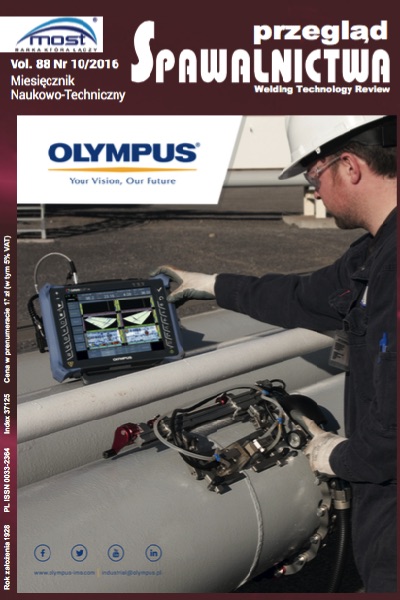Wielomodalne monitorowanie postępu zmian zmęczeniowych w stalowych elementach konstrukcji
Main Article Content
Abstract
W artykule przedstawiono koncepcję wielomodalnego systemu monitorowania zmian stanu konstrukcji stalowych zachodzących w wyniku oddziaływania obciążenia zmieniającego się w czasie. W celu monitorowania różnych aspektów zmian zachodzących w strukturze materiału w procesie degradacji, zaproponowano dwa podsystemy umożliwiające przeprowadzenie zarówno globalnej, jak i lokalnej oceny stanu materiału. Do ogólnej obserwacji wielkości zmian zachodzących w wyniku zmiennych warunków obciążenia, stanu naprężeń i zakresu obszarów odkształceń plastycznych, zastosowano termografię podczerwoną (IRT) i metody elektromagnetyczne niskich częstotliwości związane z monitorowaniem procesu magnesowania polem AC (EM). Natomiast do badania obszarów krytycznych, zagrożonych powstawaniem odkształceń plastycznych w wyniku oddziaływania składowej siły obciążającej stałej w czasie użyto metodę IRT przy wsparciu metody mikrofalowej (MW). Połączenie tych trzech metod badań nieniszczących NDT daje możliwość uzyskania pełniejszej informacji o stanie badanej struktury.
Multimodal monitoring of damage in steel construction elements during fatigue life
Abstract
In this paper a new approach to state assessment of steel structures under a dynamic load conditions is presented. In order to monitor different aspects of materials structural changes during fatigue process, two sets of measuring methods allowing both global and local eval- uation of the structure are utilized. In order to monitor general changes state under cyclic loading conditions, together with stress level and formation of plastic deformation areas, an infrared thermography (IRT) and low frequency range electromagnetic methods related with monitoring of AC magnetization process (EM) are used. Then for ex- amination of critical plastic deformation area under static loading conditions a IRT method with support of microwave (MW) one are applied. The combination of the three methods of NDT (Non-Destructive Testing) techniques allows to obtain a more complete description of the tested structure.
Downloads
Article Details
Creative Commons CC BY 4.0 https://creativecommons.org/licenses/by/4.0/
Welding Technology Review (WTR) articles are published open access under a CC BY licence (Creative Commons Attribution 4.0 International licence). The CC BY licence is the most open licence available and considered the industry 'gold standard' for open access; it is also preferred by many funders. This licence allows readers to copy and redistribute the material in any medium or format, and to alter, transform, or build upon the material, including for commercial use, providing the original author is credited.
References
Palit Sagar S., et al.: Magnetic Barkhausen emission to evaluate fatigue damage in low carbon structural steel, International Journal of Fatigue, vol. 27, 2005, pp. 317-322.
Dobmann G., Ciclov D. C., Kurz J. H.: NDT and fracture mechanics. How can we improve failure assessment by NDT? Where we are where we go?, Insight, vol. 53(12), 2011.
B. Szymanik, G. Psuj: Infrared Inspection of Steel Structures Under Load, QIRT 2015.
X. Maladegue: Theory and practice of infrared technology for nondestructive testing, JohnWiley and Sons, 2001.
A. Bzymek, et al.: Analysis of images recorded during welding processes, 9th QIRT Conference, 2008, Poland.
Akira DEMIZ, et al.: Development of defect detection method of steel structures by digital image correlation method using induction heating, International Symposium Non-Destructive Testing in Civil Engineering (NDT-CE), 2015, Germany.
G. Psuj, T. Chady, M. Enokizono: Observation of material degradation under fatigue and static loading condition using selected electromagnetic NDT methods, Material Science Forum, vol. 721, 120, 2012, 120-126.
J. Erdmann, H. Huang: Microwave Antenna Sensors for Fatigue Crack Monitoring Under Lap-joints, ASME 2010 Conf. on Smart Materials, Adaptive Structures and Intelligent Systems, Vol. 2
I. Mohammad, H.Huang: Monitoring fatigue crack growth and opening using antenna sensors, Smart Materials and Structures, No. 19, 2010.
F. Chocianowicz :Microstrip antenna based sensor for the detection and monitoring of crack growth in conductive material, Master Thesis, West Pomeranian University of Technology, Szczecin, Poland, 2013.
W. Wang, H. Ge, T. Liu, M. Liu: Study of Patch Antennas for Strain Mesurement, Electromagnetic Nondestructive Evalution (XVIII), 2015.
A. Daliri, A. Galehdar, S. John, W. S. T. Rowe, K. Ghorbani, Slotted Circular Microstrip Patch Antenna Application in Strain Based Structural Health Monitoring, AIAC14 Fourteenth Australian International Aerospace Congress, 2011.
C.A. Balanis, Antenna theory analysis and design, 3rd ed, Wiley & Sons Ltd., 2005.
P., Lopato, G. Psuj, M. Herbko , M. Maciusowicz, Evaluation of stress in steel structures using electromagnetic methods based on monitoring of AC magnetization process and utilization of microstrip antenna sensor, WD 2016 Conference, Lublin.
O.Stupakov, I. Tomas, Hysteresis minor loop analysis of plastically deformated low-carbon steel, NDT&E International, 2006, 39, 554561.
C. C. H. Lo. et al., Structural Characterization, and Magnetic Properties of Steels Subjected To Fatigue, Review In Progress of QNDE 19, 509 (2000), 1597-1604.
G. Psuj, Fusion of Multiple Parameters of Magnetic Testing Results for Damage Assessment of Loaded Steel Structures, Studies in Applied Electromagnetics and Mechanics, Vol 40: Electromagnetic Nondestructive Evaluation (XVI), pp.192-199.
A. Sorsa, Prediction of material properties based on nondestructive Barkhausen noise measurement, Acta Universitatis Ouluensis, C Technica 442, Oulu, 2013.
L. Padovese, N. Martin, F. Millioz, Time-frequency and Time-Scale analysis of Barkhausen noise signals, Proceedings of the Institution of Mechanical Engineers. Part G, Journal of Aerospace Engineering, 2009, 223 (5), pp. 577-588.
S. Pawlak, M. Różański, S. Stano, G. Muzia, Termografia aktywna jako nowa metoda badań nieniszczących połączeń zakładkowych spawanych laserowo, Przegląd Spawalnictwa Welding Technology Review, Vol 86, No 3 (2014)
D. Mężyk, Magnetyczna ocena naprężeń w instalacjach rurociągowych z wykorzystaniem efektu Barkhausena, Przegląd Spawalnictwa Welding Technology Review, Vol 86, No 5 (2014)
D. Kukla, P. Grzywna, R. Karczewski, Ocena rozwoju uszkodzenia zmęczeniowego na podstawie zmian odkształcenia i parametrów prądowirowych w kolejnych cyklach obciążenia, Przegląd Spawalnictwa Welding Technology Review, Vol 86, No 5 (2014)
